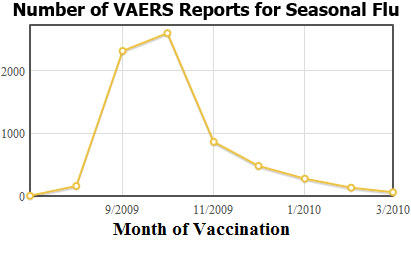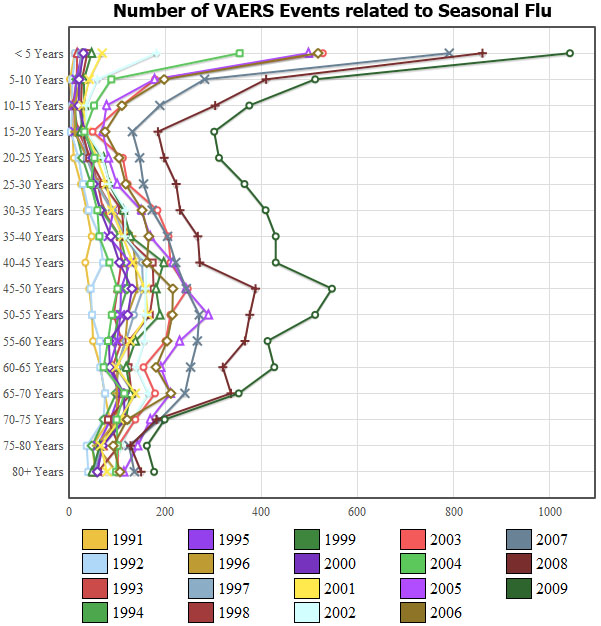
Information Center
Your Health. Your Family. Your Choice.
 |
National Vaccine Information Center Your Health. Your Family. Your Choice. |
The MedAlerts Blog |
Flu season is over, thank goodness. Reports of Flu-related vaccine injuries followed a standard curve, peaking in early winter:

Who should get the Flu shot?
I will limit this question to age recommendations, not health recommendations. And I'm not considering this year's H1N1 Flu vaccinations, just the yearly Seasonal Flu.
The CDC recommends that people from 6 months of age to 19 years old, and also people above age 50, should get a yearly Flu shot. Those between age 20 and 50 are less likely to need one.This recommendation is based on the risk of having complications from getting the Flu. What about the risk of having complications from getting the Flu shot? Are certain age groups reacting to the vaccine more than others?
Let's find out.
We will ask MedAlerts to look at all of the VAERS events that mention the Seasonal Flu vaccine, and to make a graph of the patients' ages, broken down into 5-year brackets. In addition, we will ask that each year of data collection be shown separately, so that trends can be seen.
That graph is shown below. You can skip now to the graph and my comments below it, or read on to find out how that graph was made.
To make this graph for yourself, start by going to the MedAlerts search page. Before doing anything else, check "Expert Mode" in the upper-right. "Expert Mode" turns on many advanced search features, including a feature we need here: powerful age groupings. Then do this:

It is no surprise that 2009 (the green circles) is the year with the highest numbers and 2008 (the maroon "+") has the next highest...VAERS events are increasing every year. What is interesting is that the lines have a similar shape every year. This lets us see trends that span across individual drugs and years.
The first thing that stands out in the graph is the very large numbers for 0-5 year olds. Even the next bracket, 5-10 year olds, are affected strongly. One obvious explanation for this is the large number of vaccinations that are given to children, and the possibility that the adverse events are from some other vaccine that was given at the same time as the Flu shot. Nevertheless, it is impossible to tell for sure, so the Flu shot may still be a contributing factor.
Perhaps more suprising is the peak in the 45-55 year olds. Many of these people are not even advised to get the vaccination, and yet they report injuries at significant rates every year.
The trends that appear in the graph suggest a change to the CDC's age recommendation for who should get the Flu shot. It would seem, given the rate of VAERS reports associated with the Seasonal Flu vaccine, that children under age 10 should not receive it. Perhaps young people should only be vaccinated against Seasonal Flu when they are over 10 years of age, not starting at 6 months as the CDC recommends. Similarly, it may be preferable that older people start getting vaccinated when they are 55 years and up, not 50 and up as the CDC recommends, because of higher rates of Flu vaccine injury in the 45-55 age group.
<< 2/2010: MedAlerts vs. CDC Wonder 4/2010: Getting multiple vaccines at one time >>
Copyright ©
2024 National Vaccine Information Center. All rights reserved.
21525 Ridgetop Circle, Suite 100, Sterling, VA 20166